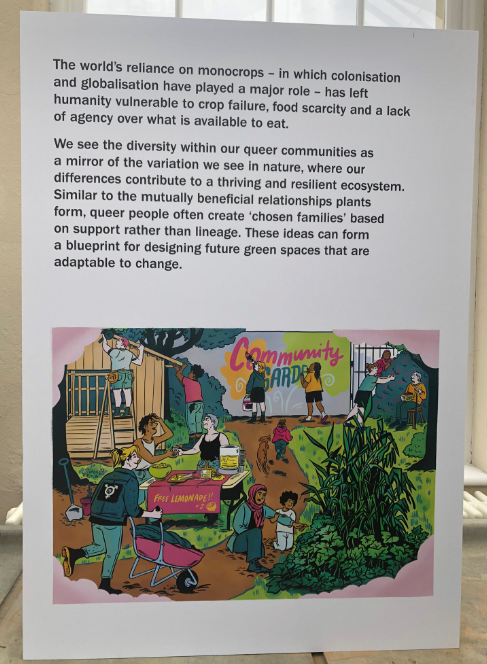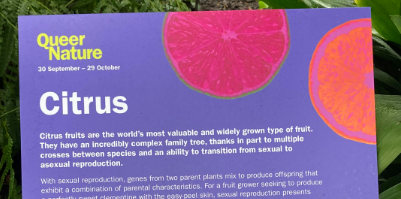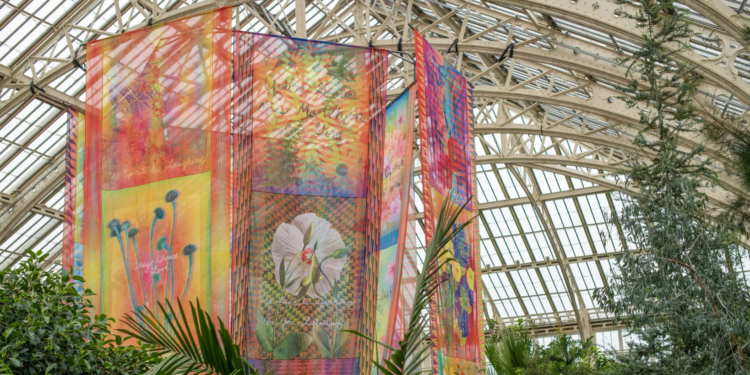Kew Gardens has been hosting a Queer Nature exhibition. “Looking at plants and fungi through a new lens sheds a light on the infinite diversity found in nature,” says the blurb. Kew Gardens is one of the world’s great institutions dedicated to the study and preservation of nature. So if anyone is going to do ‘Queer Nature’ well, it will be Kew. This exhibition is therefore going to be as good an exploration of queer nature and queer theory as you will get anywhere.
If you go into the exhibition knowing a little about queer theory, but seeking to learn more, you detect three threads.
The first is that while humans seek to categorise things, these categories sometimes have blurry boundaries. The trouble is that we know this already – queer theory doesn’t add anything. Often categories don’t have blurry boundaries. But at other times, they do. Humans have categorised clouds for example. Are cloud boundaries blurry? I expect they are not in their scientific definitions, but are in real life. So humans like to categorise things, and when boundaries are blurry, humans like to explore that blurriness, change the focus, to see if they can spot a sharp boundary somewhere after all. This is all obvious – and queer theory just doesn’t add anything new. Except that it seems to imply that there is someone out there trying to hide the fact that boundaries are sometimes blurry. Even perhaps, that someone is trying to exert political power by hiding the fact that boundaries are sometimes blurry. But there isn’t. Yet queer theory does entice young people into this conspiratorial way of thinking and the paranoid idea that there is some ‘other’ out there, trying to hide information or to exploit them.
The second thread that comes through in the exhibition is that not all forms of reproduction in nature involve two sexes and sexual reproduction. Again, the trouble is that most of us learned this at school. The exhibition has posters explaining non-sexual production in various plants. This is interesting, but, again, the gloss of queer theory doesn’t add anything at all. There is, again, the implication that someone somewhere was trying to hide plant variety. But nobody was. Queer theory states something obvious, with its only contribution being to overlay it with a degree of conspiratorial thinking.

The third thread is liberation. Queer theory – and Queer Nature – draw attention, as noted, to the fact that boundaries are blurry and that not all plants reproduce via sexual reproduction. Simple stuff that we knew. But there is a mood of new perspectives and liberation from pointing this out. This would be fine if there wasn’t that implied sense that someone somewhere had tried to hide information, impose constraints, from which the liberation. But nobody was.
There are some beautiful fabrics displayed. There are the posters explaining plant reproduction. The centrepiece of the exhibition is a video in which Kew employees and associates explain what queer nature means to them. It’s mostly from this that I have teased out the three strands above: two things that we know; the conspiratorial overlay, then the liberation from it. Queer theory contains nothing new, explains nothing, but has this paranoid overlay of implied hidden information, attempt at repression. The gullible are misled into believing in an ill-defined repressive ‘other’ out there somewhere – and this type of belief usually leads to people behaving badly.
Nevertheless, I came away from the Queer Nature exhibition thinking that Kew Gardens has done the world an unexpected favour – though not in the way intended. A great science-based institution has aimed to take queer theory seriously. It has thrown time, resources and expert staff knowledge, at queer theory. It has aimed to showcase queer theory’s insights and its explanatory power. And it has exposed that there is nothing there.

Perhaps we should encourage all institutions to take such a deep dive into queer theory. We will see them, too, come back with nothing. Because while clouds have blurry boundaries, humans do not. While mushrooms might reproduce asexually, humans do not. Queer theory does not help us to explain the human condition, nor does it help to solve policy issues. Women still want single-sex spaces even if mushrooms are asexual.
Caroline Ffiske is a Director of Conservatives for Women. Find her on X (Twitter).
Stop Press: Policy Exchange has also taken a pop at the Kew Gardens’ Queer Nature exhibition in its latest History Matters Report. It quotes Jerry Allen Coyne, a Professor Emeritus at the University of Chicago in the Department of Ecology and Evolution, who said:
The fact that flowers are hermaphrodites doesn’t either buttress or denigrate ‘queerness’. These are hermaphrodites, and hermaphrodites are not known in humans in a form that is fertile as both male and female. (We do have some human hermaphrodites, but they are almost vanishingly rare and are never fertile as both male and female.) …
They also mention fungi, which have ‘mating types’ that can number in the hundreds, but this is the exception among organisms and not seen as ‘sexes’ by biologists.













To join in with the discussion please make a donation to The Daily Sceptic.
Profanity and abuse will be removed and may lead to a permanent ban.
I think you have to weight the cost of a life in favour of the young. Any other approach seems unnatural.
Any analysis that doesn’t include a notional cost of lost liberty on the cost side is severely lacking. Governments pay people compensation for wrongful imprisonment.
LOCKDOWN DON’T Work – they kill old people they don’t save old people
Mask don’t work
Where Are the Scientific Studies for Universal Masking?
Why Masks Are a Charade Analysis by Dr. Joseph Mercola
https://articles.mercola.com/sites/articles/archive/2021/08/23/masks-are-charade.aspx?ui=1fb065e0c4152b58bd4ed94cf29c7cbfad40307fb723460ddabacd55f3c58b0c&sd=20210518&cid_source=dnl&cid_medium=email&cid_content=art1HL&cid=20210823&mid=DM965507&rid=1242686923
Stand in South Hill Park Bracknell every Sunday from 10am meet fellow anti lockdown freedom lovers, keep yourself sane, make new friends and have a laugh.
(also Wednesdays from 2pm)
Join our Stand in the Park – Bracknell – Telegram Group
http://t.me/astandintheparkbracknell
Ouch! I’m hoping that the Daily Sceptic looks with disfavor at the citing of dens of kookery like mercola.com
Yes, there’s a reason they used to say women and children first. Of course that doesn’t mean the old don’t matter or that we should euthanise them. But any adult who puts their own life before children’s should be ashamed.
I’m 74. I have 5 granddaughters aged between 22 and 7. Let’s face it, their likely value to society far outweighs mine. They should have been the priority over the last 18 months. I have my degrees and professional qualifications, I have worked but have been retired for years, therefore I do not make an valuable contribution to the national economy. They have had their futures blighted by the over 50s politicians who have also had their chance to learn. I am a drain – they have a productive lfe ahead of them, in spite of the last 18 months. I don’t want to be got rid of, but I am clear headed enough to know that my value is far less than theirs.
Those preferred value numbers still seem ridiculously high – no doubt to try and get the correct answer.
Do they mention the value of someone who will die in the next month covid or no covid?
My guess is we’d soon come to the obvious conclusion without having to conduct a study.
Removed. Rephrased as a top-level comment,
This sort of analysis does very little to convince people one way or the other.
There are so many arbitrary assumptions like the value of each life or the number of people “saved” that if one disagrees with the conclusions one need only take a few shots at the assumptions and retreat back into the comfort of one’s firmly held belief.
What is the assumption about “lives saved” (by shielding measures)? How do these experts determine this estimate? Seems to me the only way you could calculate “lives saved” would be to compare two similar nations that used completely opposite mitigation strategies – One nation did essentially nothing and another did essentially everything. Then you compare the fatalities from COVID.
Unfortunately, we have only one nation – Sweden – in the “placebo” group to perform such “scientific” comparisons. Still, this one comparison does reveal that there is no statistically significant difference in deaths in Sweden to most of the other countries that did use all the lockdown measures, especially when you look at the age cohorts before retirement age.
In America, one could compare mortality data from Alabama – which had much more stringent mitigation mandates – than its neighboring state of Florida. Florida has better mortality statistics on a per capita basis than Alabama. And Florida has more elderly citizens than any state in the union except maybe California.
In other words, more lives were seemingly “saved” in Florida than in Alabama. But this comparison doesn’t fit the narrative, so we can’t use it, I guess.
https://www.covidchartsquiz.com/state-vs-state
Covid charts quiz. Spot the mask mandates and the lockdowns…
So even better still when you look at age groups
There is no benefit in lockdown because communism has no benefits, mediaeval superstition has no benefits.
Oh dear. Political illiteracy strikes again. What we’ve got ain’t ‘communism’ by any stretch of the imagination.
Lockdown is communist, it is a policy imported from a communist dictatorship that has concentration camps.
No, we don’t have communism.
Communist countries didn’t have communism either.
Some more equal, were they?
No, it’s fascism!
Reminds me of that sketch about comminazis.
The only similarity I see is that neither works.
Both communism and medieval superstition seem to lead away from Liberty and towards our current economic model namely Feudalism (although it’s more stealthily done, even though economic-rent is at at historical high).
There was a story a few years back about Europe’s last feudal society (Sark, I think) coming to an end. Didn’t stay away long, did it?
On the contrary, communism always works, it always succeeds in achieving its goal of destruction for the sake of destruction.
Were any lives ‘saved’. Most commentators, even ‘pro lockdown’ ones seem to say all that happens is the can is kicked further down the road. The impact on overall mortality is minimal at best.
Quite. Given the age and co-morbidity profiles of deaths of/with Covid, the likelihood is that a high proportion of these “saved” people would have died anyway soon, either due to Covid catching up with them or to their existing age/conditions.
We haven’t really saved any lives, which can be verified by looking at the all-cause mortality figures. There is no exceptional about last year in terms of deaths
In a rational world, the latest all cause mortality from Belarus would surely be seen as conclusive (I suppose the BBC didn’t cover it…).
No, of course not. The lives “saved” by lockdowns (which I don’t believe) are more than outweighed by the ones lost by all manner of other conditions, some of which have not yet been able to be calculated (how many suicides, deaths from mental illness, bankruptcy, consistent abuse etc). hese are long term figures, which will not become evident for years.
To the rational mind, it is clear that lockdowns ‘weren’t worth it’. There are simply no significant benefits that can be pinned down, whilst the horrendous costs are plain to see.
But … all these analyses depend on the ‘assumptions’ that are made, and then turned into further assumptions about very dodgy monetary equivalents.
The real problem is that governments in general have made no attempt to analyse the immense obvious penalties of lockdowns against the lack of any claimed and unobvious benefits.
Basically, the exercise is fundamentally flawed.
European COVID-19 Vaccine adverse reactions report.
How’s that line up (in terms of numbers jabbed in the EU vassal states) with the UK’s 1500+ jab victims?
It doesn’t.
I’m convinced our total deaths post-vaccination are too low. At a rough guess, at a minimum it should be at least double, and possibly much higher than that, if we assume only 10% of adverse reactions are recorded.
30 day FB ban for posting this!!!!
The real cost, the human cost, the psychological and spiritual cost, has been incalculable.
People are not numbers or economic units.
Seems to me, we need to make just two observations:
Therefore, the “life cost” of Covid19 is zero and the benefits of the Covid19 response is zero.
Disclaimer: Getting on a bit myself, so I’m heading into the higher-chance end.
I’m 74. My 5 granddaughters matter more in terms of the future than I do. I’ve had my working and academic life, my qualifications, my youth (long, long ago) and it they who should have been prioritised. Blow the emotive response of stupid, politicians and so called experts (who are nothing of the kind) that we mustn’t “kill Granny”. This grandma thinks the young should have been prioritised. I don’t want to die, but I am less valuable than they area and to say otherwise is irrational.
Re: The “lives saved” assumption all we can do is look at the ONE “placebo” nation that did not implement “shielding” measures to save lives or slow spread. This nation of course is Sweden.
In the entire nation of Sweden, fewer than 100 people under the age of 40 have died of COVID.
Sweden has more than 14,000 deaths but the average age of a COVID victim is 82.
Apparently, FEWER people under 70 died in Sweden than in nations that went all in on lockdowns. So one could validly argue that no lives were “saved” by the mitigation mandates.
Yes, the benefit side looks to be zero or negative. I’d say it’s very hard to prove to any reasonable degree there was any benefit, so the assumption is that it was zero. The cost side is easier in that whatever approach you take, it’s going to be massive. In truth, the calculation can be done on the back of a postage stamp.
The economic value of a life is assigned and adjusted according to age. Reid’s calculation considers deaths in terms of economic loss. But might not the creeps behind this scam, have looked at the vulnerable (very old, frail, obese) and seen a value to be gained from their deaths?
So even as a decaying old bat I am worth 1.5 million dollars?lHow much does thirty pieces of silver go into 1.5 million dollars?
In my opinion, doing a cost-benefit analysis of lockdowns is fundamentally misguided because it implicitly accepts the assumption the people are essentially the same as cattle, hence, manageing them in them same way is principally ok and the only question here is whether or nor a particular attempt at manageing peoplecattle was efficient.
I’m not a cow. I object to being treated as such. In particular,
I could continue this list, but these are the three most important points which came to my mind.
Meanwhile: in the Philippines, draconian lockdowns continue.
https://mailchi.mp/tomwoods/goodbadnews?e=8e86beb5bb
“due to the so-called “delta” variant, citizens are expected to remain at home for two weeks (a tired trope by now) and may only exit their residences for essential items with a quarantine pass (one per household). Outdoor exercise was allowed until yesterday, but the authorities probably got spooked into banning it when they saw people still outside enjoying themselves (or trying to be healthy) and not cowering in fear at home.”
In New Zealand, lockdowns have been extended. Parliament suspended. Dissidents rounded up, or getting visits from the police for “re-education”, and Jacinda Ardern has sent $3million to the Taliban.
https://m.youtube.com/watch?v=tb0uDUGU50Y
In Australia, there have been large public protests, and the police have used pepper spray and rubber bullets in response.
https://m.youtube.com/watch?v=bD5-1Z1LXeU
Truckers in Australia are planning to bring Australia to a halt, telling people to stock up on food for at least two weeks.
Would anyone have believed this back in 2019??
Bears. Woods. Popes. Catholics. Fictional Detectives and Excrement. FIGHT. BACK. BETTER. Useful information, links and resources: https://www.LCAHub.org/
2 million lives saved by lockdowns? I don’t see how this can possibly be credible, looking at all cause mortality from Belarus. No lockdowns, no restrictions, no disaster.
Lockdowns were worth it. Not to me or society as a whole. The elite has achieved exactly what they wanted…fear and control. It was planned and they probably can’t believe how stupid and compliant society actually is…and how easy it was to achieve their aim.
In the UK government’s document “The tolerability of risk from nuclear power stations” first published by the HSE in 1988 (last revised 1992) there is a UK government department estimated value put on a human life:
“The Department of Transport’s consultation exercise secured widespread endorsement for its proposed value of life for application in road transport appraisal. This value now stands at £660 000 for a life.”
Adjusted for inflation 1992 to 2021 yields £1,320,000 ($1,810,000). This is less than one quarter the estimate of $7.8 million used in the study by L. Jan Reid.
Well, d’uh!